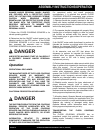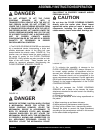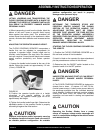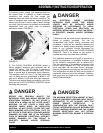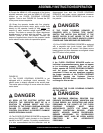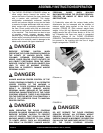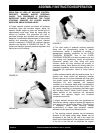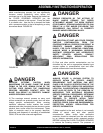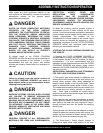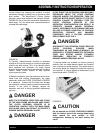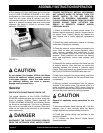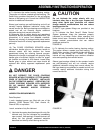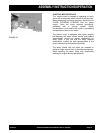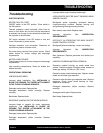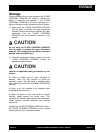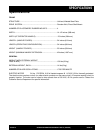
ASSEMBLY INSTRUCTIONS/OPERATION
SFCS-16 OPERATION AND PARTS MANUAL REV #3 (02/23/06) PAGE 27
water and/or any other conductive material on the
work surface can substantially increase the potential
electrocution concern for the operator and/or
associated work personnel.
DANGER
WATER OR OTHER CONDUCTIVE MATERIALS
DEPOSITED ON THE WORK SURFACE
INCREASES THE ELECTROCUTION POTENTIAL
FOR THE OPERATOR AND/OR ASSOCIATED
WORK PERSONNEL. DETERMINE THE FLOOR
COVERING SCRAPER IS PROPERLY GROUNDED
(NO FAULTS), THE EXTENSION CORD IS FREE OF
CUTS, ABRASIONS, EXPOSED CABLE STRANDS
AND THAT THE GFI PROPERLY FUNCTIONS TO
ELIMINATE FAULT CONCERNS. IMPROPER
MACHINE GROUNDING, EXTENSION CORDS
AND/OR GFI CAN RESULT IN PROPERTY
DAMAGE AND/OR PERSONAL INJURY.
8) Normal usage of the FLOOR COVERING
SCRAPER will allow the build-up and accumulation of
work surface materials on the surfaces. It is highly
recommended that both the interior and exterior
surfaces be properly cleaned after the completion of
each use.
CAUTION
Failure to properly clean the interior surfaces of
the FLOOR COVERING SCRAPER can result in
dried material build-up and accumulation directly
affecting bearing service life.
DANGER
EXERCISE EXTREME CAUTION WHEN UTILIZING
ANY SOLVENT TO REMOVE ACCUMULATED
MATERIALS FROM THE SURFACES OF THE
MACHINE AND RELATED COMPONENTS. MANY
SOLVENTS ARE FLAMMABLE. DO NOT SMOKE
OR INTRODUCE FLAME IN THE WORK AREA.
PROVIDE ADEQUATE VENTILATION AND WEAR
PROPER SAFETY APPAREL.
DANGER
PROPERLY DISPOSE OF ALL ACCUMULATED
MATERIALS PER OSHA AND ENVIRONMENTAL
PROTECTION AGENCY CODES AND
REGULATIONS. MANY ACCUMULATED
MATERIALS CAN BE CLASSIFIED AS
HAZARDOUS AND REQUIRE PROPER DISPOSAL
PROCEDURES. CONTACT THE APPLICABLE
GOVERNMENT AND/OR PRIVATE AGENCIES FOR
SPECIFIC INFORMATION.
9) When the covering removal process creates a
considerable amount of loose material on the work
surface, it can become almost impossible to determine
proper material removal depths and the extent of work
already accomplished. The problem can be
compounded if a vacuum system is not utilized. Loose
material should be removed by sweeping or other,
appropriate processes and the FLOOR COVERING
SCRAPER utilized until conditions again warrant
removing the accumulated material.
STOPPING THE FLOOR COVERING SCRAPER ON
THE JOBSITE.
1) Stopping the FLOOR COVERING SCRAPER is
accomplished by moving the ON/OFF switch located
on the operator handle to the OFF position. For safety
considerations, it is also recommended that the
extension cord be disconnected from both the FLOOR
COVERING SCRAPER and electric power source
whenever the FLOOR COVERING SCRAPER is not in
use on the job site.
OPERATIONAL PARAMETERS AND TECHNIQUES
FOR THE FLOOR COVERING SCRAPER.
1) The specific type and/or density of adhesives and
mastics which bond coverings to the work surface can
directly affect removal rates. Many adhesives or
mastics remain flexible in the fully cured state. These
types of materials are usually darker or black in color.
The adhesives and mastics which become dried in the
fully cured state are usually yellowish or opaque in
color. These types of materials will usually require
less effort to remove than the dark types which remain
flexible even when cured.
2) As a general rule, the lower the adhesive or mastic
density (amount) utilized to adhere the covering to the
work surface, the lower the force required to "shear"
through the bond and thus, the greater the covering
removal rate.
3) As a general rule, the thicker the adhesive or mastic
utilized to adhere the covering to the work surface, the
greater the force required to "shear" through the bond
and thus, the lower the covering removal rate.
4) The Back-Saver™ Blade Control System is
designed to adjust blade angle relative to the work



